
PREV ARTICLE
NEXT ARTICLE
FULL ISSUE
PREV FULL ISSUE
SELECTIONS FROM THE POGUE COLLECTION, PART VWhere to start? I've had the Pogue V catalog on my desk for a couple weeks now. Amazing coins, expertly researched and catlogued. As the sale date approaches I thought I'd
pick out a few lots to highlight. -Editor
Lot 5001: The Pittman Proof 1837 No Stars Half Dime
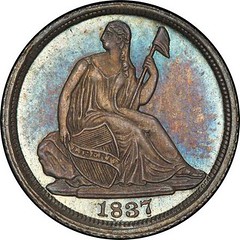 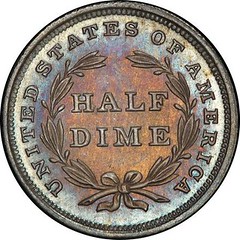 The devices are executed perfectly in this tiny jewel-like form, thanks to the technological advances of the reducing lathe introduced at the Mint following Franklin Peale's trip to study innovations in European mints. The human impact upon the dies that struck this coin was little beyond punching in the date digits. This personal touch is reflected upon examination under magnification. Each individual date punch was punched too low, with 1, 3, and 7 on more or less the same line while the 8 actually overlapped with the denticles below. Correcting this error meant effacing most of the earlier digits, but not their bases, which remain. The die rotation, also set by human hands, shows the reverse to be a few degrees left of proper coin turn. After the Liberty Seated design was introduced on the dollar denomination in 1836, it was shrunk to size for the half dime and dime denominations in early 1837, followed by the quarter dollar in 1838 and the half dollar in 1839. The half dime, the smallest showcase of the Gobrecht design, was first struck on July 25, 1837. "I have the pleasure to send you herewith 20 half dimes of the new emission," Mint Director Robert Maskell Patterson wrote to Treasury Secretary Levi Woodbury that day. "You will see that they are fair similes of the new dimes." Walter Breen suggested that all 20 pieces were Proofs, though the letter does not specify. PCGS has certified an 1837 Proof on 10 occasions, though this figure is undoubtedly greater than the number of discrete specimens they've seen. Pittman had a great eye and sense of value - his purchases of early proof coins were the bargain of the last century. These are important and very rare coins. -Editor
To read the complete lot description, see:
Lot 5011: The W.W. Neil - Pittman Gem 1837 No Stars Proof Dime
  Research by John Dannreuther has found that Proof 1837 Seated Liberty dimes were struck on three occasions with three discrete die alignments. One he measures as 20 degrees clockwise, as seen here, is found on those coins struck from the earliest state of the dies and represents the very earliest production of Proof dimes of this design type. Other recognized rotations are proper coin turn and a slight twist, roughly 10 degrees, counterclockwise. Dating the production of the first 1837 No Stars dimes remains challenging. Breen frequently mentions, without citation, a letter delivering 20 new dimes dated June 30, 1837; this missive has evolved between his 1950s publications to those in the 1980s from a letter presenting new dimes to an order that "the newly completed Gobrecht dies ... be placed into the dime press" to create "some 30 brilliant proofs ... for presentation to Treasury officials and other VIPs." A July 25, 1837 letter presenting a small group of new half dimes to the Treasury Secretary does mention that dimes had already been produced and calls the new half dimes "fine similes of the new dimes." The June 30, 1837 date for initial distribution of new dimes is likely correct, and those new dimes could well have been Proofs, but confirming either of those likelihoods as facts is perhaps impossible. Were it not for the reducing lathe technology that Franklin Peale brought to the Philadelphia Mint after 1835, it would have been well nigh impossible to create such a diminutive example of Christian Gobrecht's enduring No Stars design. The hubs for Seated Liberty dimes such as this were made in perfect proportion to their dollar progenitors, then delicately touched up by Mint engravers. The process was well described in the December 1861 issue of Harper's New Monthly Magazine in an article by Waldo Abbott that was later serialized in Mason's Coin and Stamp Collectors Magazine in 1870: Look at the bas relief of Liberty on one side of a coin. It would be exceedingly difficult to design this in hard steel and of so small a size; so they first make the design in wax, probably six times as large as the coin, by which means the beautiful proportions can be obtained. From this a brass cast is taken and reduced on steel to the size of the coin by a transfer or reducing lathe. This ingenious instrument was introduced from France by Mr. Peale, who also operated it for some time. To read the complete lot description, see:
Lot 5038: The Amon Carter 1801 Dollar
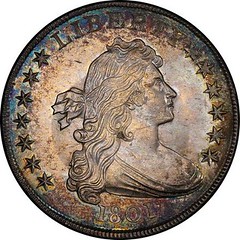 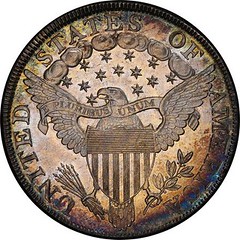 The Amon Carter collection's assemblage of early dollars is the stuff of numismatic legend. Most of the coins were acquired in the 1940s, particularly from Carter's Fort Worth friend and neighbor B. Max Mehl. The introduction to the Carter dollars in the January 1984 Stack's catalog notes, "the vast majority of the coins" came from Mehl's 1947 W.W. Neil sale and his 1950 Golden Jubilee auction. This piece unquestionably came from the latter, where lot 797 was a specimen of this die variety described as "Brilliant Proof" with "a peculiar halo or shadow around the bust." Mehl went on to note the coin was "as beautiful a specimen of the early silver dollar of any date that has ever come to my attention" and traced its provenance to the Colonel Green Collection for the substantial sum of $100. While unplated, there is simply no other specimen of this variety that closely resembles this coin or Mehl's description. For that matter, no other 1801 dollar of any variety compares to this one. The sole other MS-65 (PCGS) coin is a BB-212, frosty rather than prooflike, beautiful but considerably different in its appeal. That coin, perhaps unsurprisingly, also traces its provenance to the Col. E.H.R. Green Collection. A beauty of a coin. -Editor
To read the complete lot description, see:
Lot 5054: The Harlan Page Smith 1805 C-1 Half Cent
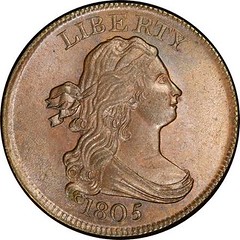 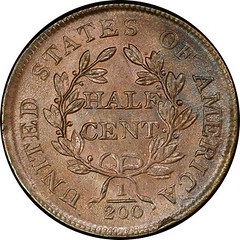 Though half cent collectors cherish provenance, very few half cents offer a chain of ownership that extends over a century. This example traces its lineage to the personal collection of legendary dealer Harlan Page Smith, half of the partnership that offered the collections of Lorin G. Parmelee, Robert Coulton Davis, and George D. Woodside, among others, as New York Coin & Stamp Company. Smith and David Proskey joined forces in 1888, following Smith's brief business arrangement with H.G. Sampson and nearly a decade cataloging and auctioning collections on his own. The most famous of his solo sales offered the cabinet of Dr. Edward Maris, the Philadelphia physician whose name remains synonymous with the New Jersey copper varieties he described in an 1881 monograph. Smith died March 2, 1902, at home on West 52nd Street in New York City, next door to the modern Neil Simon Theatre between Broadway and 8th Avenue. His obituary, penned by Lyman Low and published in the American Journal of Numismatics, reports that he was born Upstate in 1839 and spent his youth as a mariner "roving over distant parts of the world." A career as a fruiterer followed, but in 1876 he retired to devote himself to his love of numismatics full time. Low noted that Smith "was always credited with good judgment" and "proved a bold operator" due his extensive knowledge of coins. "Quick to discern pieces of special rarity or value," Smith socked this half cent away for his own cabinet, recognizing it as perhaps the best, or at least one of the best, he had seen. Anoher beautiful early coin, with a great ownership pedigree. -Editor
To read the complete lot description, see:
Lot 5074: The Garrett 1831 Reverse of 1836 Half Cent
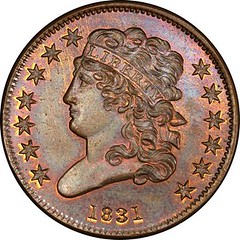  There is likely no such thing as an 1831 circulation strike half cent, though a somewhat worn piece in the Missouri Cabinet was assigned a grade of AU-55 by PCGS. Instead, there are three varieties of Proofs that collectors can choose among to own an example of this date. Original 1831 half cents, struck in Proof finish in 1831, are extreme rarities, with perhaps a dozen known. The 1831 half cents with the reverse type of 1840 were coined much later, perhaps as late as the 1870s, and are also extremely rare. Just five are known, including the specimen in the next lot. Most date collectors end up acquiring an example like this, if they ever find one at all. The 1831 First Restrikes use a reverse from 1836 and were likely coined in the late 1850s, when interest in United States copper coins first began to blossom. There may be as many as three dozen 1836 First Restrikes known, most somewhat handled. Rick Coleman identified 32 provenance chains in the pages of Penny-Wise, but the listing for this coin was actually for two different specimens that looked remarkably similar. Others appear not to have made the list at all, including the example offered as lot 2112 in the June 2004 Medio sale by Stack's and American Numismatic Rarities. This appears to have the oldest provenance of any 1831 First Restrike currently traced. Coincidentally, it is also one of the first struck, coined from a perfect state of the dies with neither swelling nor the crack that bisects the reverse in later states. Coleman's research found 20 early die state pieces. The only other specimens that Coleman was able to trace to before World War I are the New York Public Library coin (donated by Thomas Addis Emmet in the late 1880s), the Gschwend coin that was sold as part of Auction '80, and the Eliasberg coin that John H. Clapp had acquired at the 1904 Mills sale. This coin, purchased by T. Harrison Garrett before his demise in 1888, was among those deaccessioned by Johns Hopkins University in 1976 to be sold by Stack's. It appears to have sold publicly just twice since. Another one-two punch - a great high-grade coin with a great pedigree. -Editor
To read the complete lot description, see:
Lot 5096: Helfenstein 1794 Sheldon-26 Large Cent
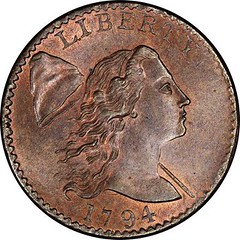 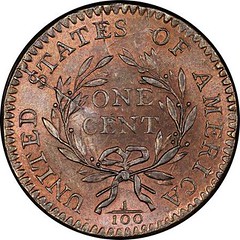 This cent found its way to Louis Helfenstein in the late 1950s or early 1960s, soon after it first emerged from the woodwork. Those years after the publication of Penny Whimsy were an era of significant change within the close knit large cent community. The men of the pre-war generation had passed: Hines, Newcomb, Wurtzbach, Clapp, T. James Clarke, Homer Downing, and others. The marketplace for cents, both in terms of collector interest and available information, had changed enough that the initial edition of Dr. Sheldon's book, Early American Cents, required substantial updating, which Sheldon undertook with two new co-authors, Walter Breen and Dorothy Paschal. C. Douglas Smith, who sold this coin to Helfenstein about 1960, described his late friend in some detail in the July 1978 issue of Penny-Wise. Lou right away got interested in collecting large cents, and he early decided to collect just the top quality large cents. As far as prices went, he just decided to buy any coin he liked and the heck with the price, and he had enough money to do it. In a very few years, he formed an excellent collection because he only bought Mint State coins. At that time, he would pay more than most people and he had pretty good opportunities because he was right in New York. Helfenstein's approach did not sit well with everyone, including Dr. Sheldon's co-author and close friend, Mrs. Paschal. "Helfenstein was not a collector in my opinion - he was merely a speculator who started buying gem coins a few years ago - half a dozen years or so," Paschal wrote in 1964 to contemporary collector Dr. Robert Carter. Lester Merkin's catalog was groundbreaking: it was the first to use color photography, the first to photograph nearly every lot, and the first to use the sort of artful cover layout that would become de rigeur of most numismatic auctions in later decades. Still, the novelty of it perturbed Paschal and many of her contemporaries. Merkin's catalog of the Helfenstein collection is a landmark in numismatic literature, raising the bar for all catalogs coming afterwards. Its classic cover photo of large cents
appears on the home page of the Numismatic Bibliomania Society's web site. -Editor
To read the complete lot description, see:
Lot 5106: 1797 Cent from the Nichols Hoard
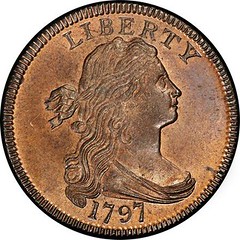 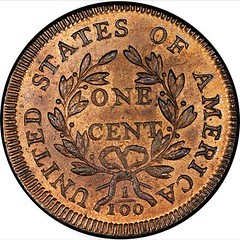 The coins of the Nichols Find trace their lineage to David Nichols of Salem, Massachusetts, who lent his name to a small group of Mint State cents dated 1796 and 1797 that were in his possession. Nichols lived near Gallows Hill, made famous by the unsavory aftermath of the Salem Witch Trials, and died in Salem in 1882 at the age of 72. In comments to the April 1917 meeting of the Boston Numismatic Society, published in The Numismatist in August of that year, John Robinson recalled his days as a young collector living nearby. David Nichols, living near Gallows Hill, would occasionally open the bag of mint-bright cents of 1796 and 1797 and give us one of each. The lot came, it was said, from the Hon. Benjamin Goodhue, who received them in part pay for his services in the U.S. Senate. As I remember them at the time there were about 50 or 60 of each date in the bag. W. Elliot Woodward, the Roxbury coin dealer and druggist whose writings made him a window into the numismatic world around Boston from the 1860s through 1890s, corroborated Robinson's story in his January 1882 sale. "When I first saw these cents, they were kept in a bag in which Benj. Goodhue, the grandfather of Mrs. Nichols, brought them from Philadelphia in 1797." Oral history is an excellent but imperfect source, often grasping the heart of a story without mastering all the particulars. See the excellent catalog description for more background on the Nichols Hoard. -Editor
To read the complete lot description, see:
 Wayne Homren, Editor The Numismatic Bibliomania Society is a non-profit organization promoting numismatic literature. See our web site at coinbooks.org. To submit items for publication in The E-Sylum, write to the Editor at this address: whomren@gmail.com To subscribe go to: https://my.binhost.com/lists/listinfo/esylum All Rights Reserved. NBS Home Page Contact the NBS webmaster 
|